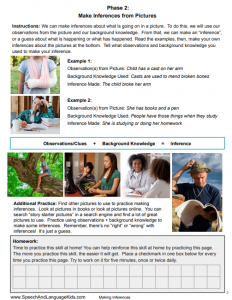Perspective Taking Speech Therapy
- Lauren DiBiase’s Site: www.slplaurendibiase.com
- Social Skills for Super Kids: https://www.teacherspayteachers.com/Product/Social-Skills-for-Super-Kids-1652388
If you’d rather listen to the audio version of the Speechie Show, click here:
Or if you prefer to read the transcript, see below:
Welcome to the Speechie Show! Being a speech language pathologist often means having too much work and not enough planning time. To beat the overwhelm, we’re bringing you the tricks and tools that will make your job a little bit easier.
Carrie: Hey everybody, welcome to the Speechie Show. I am here today with Lauren DiBiase and she is from slplaurendibiase.com and today we are talking about perspective taking. So, we are talking about helping our students who have social language problems, be able to take the perspective of someone else. Which can be quite a challenge for some of our students. Especially those with autism or pragmatic language disorders.
So, if you’re new to the show, my name is Carrie Clark. I run speechandlanguagekids.com. Where I have resources for speech and language pathologists and parents. And we do this Speechie Show once a week. We try to do it every Monday afternoon and we get on with another speech and language pathologist and we chat about one topic. Give you five tips and tricks, share resources and then we do a giveaway. So, if you’re watching with us live on Facebook, stay tuned for that giveaway. That’ll be in just a few minutes. While we are getting everybody on here, looks like we have some people coming on live, go ahead and type in yes or no, are your students having trouble with perspective taking. I’d like to see how far spread this is. Do you have students with the perspective taking issues or is this not something that you’re dealing with a whole lot right now? So, Lauren, why don’t you go ahead and introduce yourself and tell us what you’ve got going on right now.
Lauren: Ok thank you. Hi my name is Lauren DiBiase. I am an SLP who right now works for the New York City Department of Ed in Queens. I also run a blog slplaurendibiase.com. So, I talk about perspective talk today because a lot of my students this year have autism or are emotionally disturbed. And I’m seeing this common trend of students who are struggling to make friendships, struggling to build relationships because they cannot take the perspective of another student. So, I’ve been really researching. I’ve been paying. I’ve really been finding creative ways to make learning about other people’s perspectives fun.
Carrie: That’s wonderful. And Lauren has a giveaway that she’s doing today that is a social skills pack so hang tight for that. Plus, we’ll be doing the giveaway for my membership. So, if you want to hang tight for that, we’ll have a giveaway for that as well. And don’t forget to share this Facebook live so we can spread it to other people as well. So, we’re going to jump in with 5 points. We’re going to talk about 5 tips for working on perspective taking. And the first one we’re going to talk about is group therapy versus individual therapy. Lauren tell us your take on group versus individual.
Lauren: Absolutely. So, obviously, you have to go based on your student’s mandate. Are they mandated to be in a group? Are they mandated to be individual? Or do you have kind of a combination of both? I always recommend when you are working on social skills to group your students. It’s wonderful if they learn to perspective take with an adult, but in life they need to be able to do it with their peers. And in classrooms all over. So, if you have a group session, break and put your kids together. If you are scheduled to see them individually, I highly recommend pushing in to some subject that engages many students. Be it their art class, lunch time or recess. Just check with the teacher and get their permission first so that you’re not over stepping your boundary. But always target perspective taking with other students.
Carrie: I love that. I think we kind of overlook that sometimes when we have such crazy schedules that it may actually be best for those students to be with other students. If you guys are watching on this live, go ahead and type in if you see your perspective taking students in group or individual. Just type that in the comments, group or individual, so we can get a feel where everybody’s at. And if you guys have any questions as we go along, go ahead and type those in and we’ll answer those as we go as well. So, our first tip was to do group therapy versus individual. Our 2nd tip is to talk about being wrong versus being different. Go ahead and tell us what that looks like.
Lauren: So there’s so many foundational skills needed before a student can correctly perspective take and respect the other student’s perspective. So, I always try to start teaching that some things are different, but that doesn’t mean that they are wrong. A lot of the times I’ll do it in a survey kinds of format. So, on my white board I’ll ask a question that has some kind of very concrete visual maybe specific. I might ask what color is your hair. What color are your eyes? What color is your shirt? Something that is visual. And then I’ll ask my students, what do you think everyone’s going to say? What do you think? And they’ll always answer with their own answer. If their hair is black, they’ll say that everyone is going to say black. If their shirt is purple, they’re going to say purple. So, everyone hears everyone else’s answers. And then I start surveying each student and I write their answer on the board as they go. So, yellow, blue, black. At the end of the lesson, visually the students become aware that oh look there are all these other answers that aren’t actually wrong because oh look, Joe’s shirt is purple even though mine is blue. So, the visual will be there and then I follow it up with a verbal discussion that just supports that same lesson. It’s a beginning teaching that everyone is not the same but it doesn’t mean that other people are wrong.
Carrie: Oh I think that’s so key cause that really makes it very concrete and helps them see that difference as opposed to my way of thinking is the only way of thinking. I think that’s great. Ok we had a couple people…ooops I’m covering the camera again, I keep on doing that…people chime in. It looks like they were doing some group therapy. Good it looks like we have some people doing group therapy already.
Lauren: Great.
Carrie: Alright so we’ve talked about doing group therapy for perspective taking and talking about being wrong versus being different. So, the next tip we’re going to talk…click here to read the full transcript.

About the Author: Carrie Clark, MA CCC-SLP
Hi, I’m Carrie! I’m a speech-language pathologist from Columbia, Missouri, USA. I’ve worked with children and teenagers of all ages in schools, preschools, and even my own private practice. I love digging through the research on speech and language topics and breaking it down into step-by-step plans for my followers.
Connect with Me:








Leave A Comment